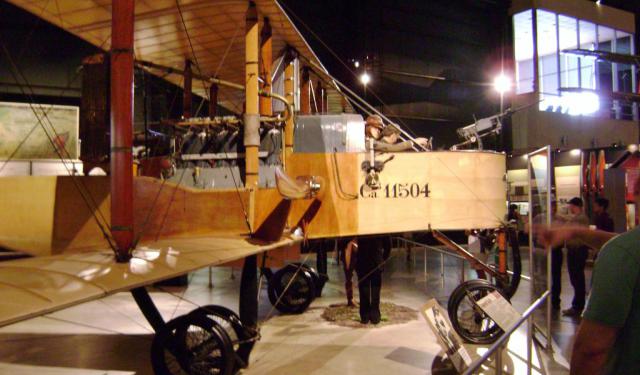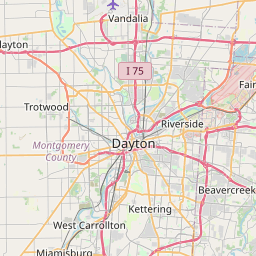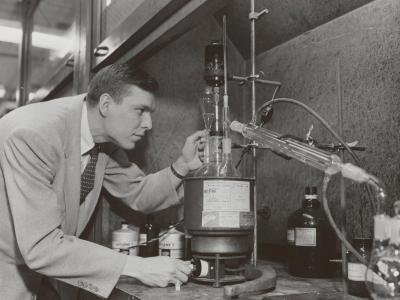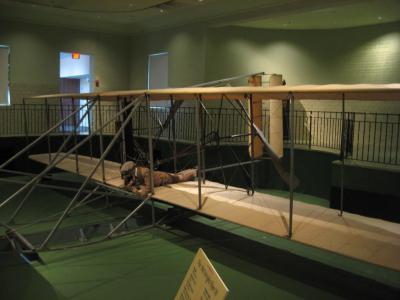
Wright Brothers Walking Tour (Self Guided), Dayton
Renowned as the cradle of innovation for the Wright brothers, Orville and Wilbur, Dayton, Ohio is rich with aviation history. The pioneers of powered flight transformed Dayton into a hub of technological advancement and ingenuity. Today, visitors to the city can explore several sites that commemorate their groundbreaking achievements.
The Aviation Trail Visitor Center and Museum is a perfect starting point for exploring their legacy. The center provides comprehensive insights into the Wright brothers' journey from dreamers to innovators.
Not far from the museum stands the Wright Cycle Company, where the brothers' path into aviation began. Initially a bicycle store, it became their experimental workshop, leading to the development of the Wright Flyer. Nearby, visitors can explore the modest Childhood Home of the Wright Brothers, which offers a glimpse into the early influences that shaped these visionary siblings.
Another critical site is The Wright Aeronautical Laboratory, now part of Wright State University. Here, the brothers refined their inventions, contributing immeasurably to modern aeronautics. Additionally, the Woodland Cemetery and Arboretum is the final resting place of Orville and Wilbur Wright.
Finally, the Carillon Historical Park and Wright Brothers Aviation Center encapsulate the legacy of the Wright brothers through extensive exhibits, including a replica of the 1905 Wright Flyer III. This park offers an immersive experience of the era that catapulted human flight into reality.
For those inspired by ingenuity and resilience, visiting these historic locations in Dayton is a must. Experience firsthand where the ambition of flight was put into practice and take a step back into a time when the sky became the limit. Embark on the Aviation Trail and let the spirit of innovation lift your imagination to new heights.
The Aviation Trail Visitor Center and Museum is a perfect starting point for exploring their legacy. The center provides comprehensive insights into the Wright brothers' journey from dreamers to innovators.
Not far from the museum stands the Wright Cycle Company, where the brothers' path into aviation began. Initially a bicycle store, it became their experimental workshop, leading to the development of the Wright Flyer. Nearby, visitors can explore the modest Childhood Home of the Wright Brothers, which offers a glimpse into the early influences that shaped these visionary siblings.
Another critical site is The Wright Aeronautical Laboratory, now part of Wright State University. Here, the brothers refined their inventions, contributing immeasurably to modern aeronautics. Additionally, the Woodland Cemetery and Arboretum is the final resting place of Orville and Wilbur Wright.
Finally, the Carillon Historical Park and Wright Brothers Aviation Center encapsulate the legacy of the Wright brothers through extensive exhibits, including a replica of the 1905 Wright Flyer III. This park offers an immersive experience of the era that catapulted human flight into reality.
For those inspired by ingenuity and resilience, visiting these historic locations in Dayton is a must. Experience firsthand where the ambition of flight was put into practice and take a step back into a time when the sky became the limit. Embark on the Aviation Trail and let the spirit of innovation lift your imagination to new heights.
How it works: Download the app "GPSmyCity: Walks in 1K+ Cities" from Apple App Store or Google Play Store to your mobile phone or tablet. The app turns your mobile device into a personal tour guide and its built-in GPS navigation functions guide you from one tour stop to next. The app works offline, so no data plan is needed when traveling abroad.
Wright Brothers Walking Tour Map





Guide Name: Wright Brothers Walking Tour
Guide Location: USA » Dayton (See other walking tours in Dayton)
Guide Type: Self-guided Walking Tour (Sightseeing)
# of Attractions: 6
Tour Duration: 3 Hour(s)
Travel Distance: 7.8 Km or 4.8 Miles
Author: sabrina
Sight(s) Featured in This Guide:
Guide Location: USA » Dayton (See other walking tours in Dayton)
Guide Type: Self-guided Walking Tour (Sightseeing)
# of Attractions: 6
Tour Duration: 3 Hour(s)
Travel Distance: 7.8 Km or 4.8 Miles
Author: sabrina
Sight(s) Featured in This Guide:
- Aviation Trail Visitor Center and Museum
- Wright Cycle Company
- Childhood Home of the Wright Brothers
- The Wright Aeronautical Laboratory
- Woodland Cemetery and Arboretum
- Carillon Historical Park and Wright Brothers Aviation Center
1) Aviation Trail Visitor Center and Museum
The Aviation Trail Visitor Center and Museum offers a fascinating journey through the history of aviation and parachute development, starting at the Wright-Dunbar Interpretive Center. Spread across two floors, the museum provides an immersive experience into what life was like in Dayton during the 1890s. Visitors can stand in the Wright & Wright Job Printers’ shop, meticulously recreated in the same office space where Wilbur and Orville Wright began their careers as printers.
The Wright brothers' journey into the printing business laid the foundation for their subsequent ventures. By 1892, they had expanded their enterprise to include a burgeoning bicycle business, showcasing their innovative spirit and entrepreneurial drive. The exhibits at the Wright-Dunbar Interpretive Center offer an in-depth look into these early years, highlighting the brothers' diverse talents and contributions to Dayton's local community before they embarked on their legendary aviation pursuits.
On the second floor of the Aviation Trail Visitor Center, the Aviation Trail Parachute Museum tells the riveting story of the development of the free-fall parachute. Originating at Dayton's McCook Field after World War I, the parachute has evolved into a critical technology for safely landing spacecraft. The museum's exhibits trace this evolution, demonstrating the significant advancements made in parachute technology over the decades.
The Wright brothers' journey into the printing business laid the foundation for their subsequent ventures. By 1892, they had expanded their enterprise to include a burgeoning bicycle business, showcasing their innovative spirit and entrepreneurial drive. The exhibits at the Wright-Dunbar Interpretive Center offer an in-depth look into these early years, highlighting the brothers' diverse talents and contributions to Dayton's local community before they embarked on their legendary aviation pursuits.
On the second floor of the Aviation Trail Visitor Center, the Aviation Trail Parachute Museum tells the riveting story of the development of the free-fall parachute. Originating at Dayton's McCook Field after World War I, the parachute has evolved into a critical technology for safely landing spacecraft. The museum's exhibits trace this evolution, demonstrating the significant advancements made in parachute technology over the decades.
2) Wright Cycle Company
The Wright Cycle Company, founded by the Wright brothers, Orville and Wilbur Wright, started as the Wright Cycle Exchange in 1892. They originally focused on bicycle repair, rental, and sales, while also running a print shop. Their bicycle business gradually expanded and relocated six times within Dayton.
In 1896, they began designing and manufacturing their own bicycles, including the Van Cleve and the St. Clair models. The company introduced innovations like the self-oiling hub and left-hand threads on the crankarm and pedal to prevent unscrewing. Their shop on South Williams St., where they worked from 1895 to 1897, is still standing and part of the Dayton Aviation Heritage National Historical Park.
The profits from their bicycle business funded their aviation experiments. By 1901, they were using a modified St. Clair bicycle to test airfoil designs and built a wind tunnel in their shop at 1127 West Third St. This site was where they also designed and built their first airplane, the Wright Flyer, which cost less than $1,000. The shop closed in 1909 as they shifted their focus entirely to aviation. The final shop building was moved to Greenfield Village in Michigan in 1937 with Orville's cooperation.
In 1896, they began designing and manufacturing their own bicycles, including the Van Cleve and the St. Clair models. The company introduced innovations like the self-oiling hub and left-hand threads on the crankarm and pedal to prevent unscrewing. Their shop on South Williams St., where they worked from 1895 to 1897, is still standing and part of the Dayton Aviation Heritage National Historical Park.
The profits from their bicycle business funded their aviation experiments. By 1901, they were using a modified St. Clair bicycle to test airfoil designs and built a wind tunnel in their shop at 1127 West Third St. This site was where they also designed and built their first airplane, the Wright Flyer, which cost less than $1,000. The shop closed in 1909 as they shifted their focus entirely to aviation. The final shop building was moved to Greenfield Village in Michigan in 1937 with Orville's cooperation.
3) Childhood Home of the Wright Brothers
The childhood home of Orville and Wilbur Wright, holds a significant place in aviation history. Built in 1909, this house was situated just a block away from the Wright brothers' bicycle shop, which played a crucial role in their journey toward inventing the first successful airplane. This historic location is now adjacent to the Dayton Aviation Heritage National Historical Park, providing a contextual backdrop for visitors interested in the legacy of the Wright brothers.
Orville Wright was born in this house in 1871, and it was here that he and his brother Wilbur began their groundbreaking pursuit of powered flight. The brothers designed and built their 1903 Wright Flyer in the vicinity, marking the inception of their pioneering work in aviation. The house not only witnessed their early years but also the blossoming of their revolutionary ideas that would change the world.
In 1936, the original house was purchased by industrialist Henry Ford and relocated to Greenfield Village at the Henry Ford Museum in Dearborn, Michigan, as part of his efforts to preserve significant historical structures. Although the house itself no longer stands on its original site, the front porch and the outline showing the room layout remain, allowing visitors to imagine the early environment of the Wright brothers. These remnants serve as a tangible connection to the past, maintaining the site's historical importance.
Today, the homestead is free and open to the public, offering a glimpse into the origins of two of the most influential figures in aviation history. Visitors can explore the site at any time, with free parking available at the nearby Dayton Aviation Heritage National Historical Park.
Orville Wright was born in this house in 1871, and it was here that he and his brother Wilbur began their groundbreaking pursuit of powered flight. The brothers designed and built their 1903 Wright Flyer in the vicinity, marking the inception of their pioneering work in aviation. The house not only witnessed their early years but also the blossoming of their revolutionary ideas that would change the world.
In 1936, the original house was purchased by industrialist Henry Ford and relocated to Greenfield Village at the Henry Ford Museum in Dearborn, Michigan, as part of his efforts to preserve significant historical structures. Although the house itself no longer stands on its original site, the front porch and the outline showing the room layout remain, allowing visitors to imagine the early environment of the Wright brothers. These remnants serve as a tangible connection to the past, maintaining the site's historical importance.
Today, the homestead is free and open to the public, offering a glimpse into the origins of two of the most influential figures in aviation history. Visitors can explore the site at any time, with free parking available at the nearby Dayton Aviation Heritage National Historical Park.
4) The Wright Aeronautical Laboratory
In West Dayton, a reproduction facade commemorates the Wright Aeronautical Laboratory, a building that stood for 60 years as a testament to Orville Wright's dedication to aviation innovation. Constructed in 1916 at the cost of over $300,000, this laboratory became Orville's workspace for over three decades. He relocated his equipment from the former Wright Cycle Shop to this new facility, where he tirelessly worked six days a week.
The laboratory was more than just a workspace; it was a hub of activity, housing the iconic 1903 Wright Flyer from 1916 to 1928. This aircraft was repeatedly assembled and disassembled for various exhibitions, including MIT in 1916, the Pan American Aeronautic Exposition in 1917, and the International Air Races in 1924, before being shipped to London's Science Museum in 1928.
The Wright Aeronautical Laboratory was a vital part of Dayton's industrial heritage. Unfortunately, despite its historical significance, the building was demolished by December 1976. Today, the reproduction facade stands on the original site, serving as a reminder of the groundbreaking achievements that took place within its walls. Photographs and memories of the laboratory are preserved, offering a glimpse into the orderly and private world where Orville Wright spent the final three decades of his life.
A historical marker titled "31 Years at the Lab" honors Orville's relentless work ethic and passion for aviation. The marker's inscription poignantly notes that at age 76, Orville was still working daily in his lab when he suffered a heart attack, leading to his death three days later at home.
The laboratory was more than just a workspace; it was a hub of activity, housing the iconic 1903 Wright Flyer from 1916 to 1928. This aircraft was repeatedly assembled and disassembled for various exhibitions, including MIT in 1916, the Pan American Aeronautic Exposition in 1917, and the International Air Races in 1924, before being shipped to London's Science Museum in 1928.
The Wright Aeronautical Laboratory was a vital part of Dayton's industrial heritage. Unfortunately, despite its historical significance, the building was demolished by December 1976. Today, the reproduction facade stands on the original site, serving as a reminder of the groundbreaking achievements that took place within its walls. Photographs and memories of the laboratory are preserved, offering a glimpse into the orderly and private world where Orville Wright spent the final three decades of his life.
A historical marker titled "31 Years at the Lab" honors Orville's relentless work ethic and passion for aviation. The marker's inscription poignantly notes that at age 76, Orville was still working daily in his lab when he suffered a heart attack, leading to his death three days later at home.
5) Woodland Cemetery and Arboretum
Woodland Cemetery and Arboretum is a historic and serene final resting place located in Dayton, that offers a unique blend of natural beauty, cultural significance, and historical importance. Established in 1841, it has grown to become one of the most renowned cemeteries in the United States, celebrated for its picturesque landscapes, architectural treasures, and its role as an arboretum.
Woodland Cemetery is renowned for its natural beauty. The grounds are maintained and feature a diverse collection of trees, plants, and gardens that provide a tranquil and peaceful atmosphere. The changing seasons offer visitors a different perspective each time they visit, with vibrant spring blossoms, lush summer greenery, and colorful autumn foliage.
Woodland Cemetery is recognized as an accredited arboretum, making it a unique destination for tree enthusiasts and botany lovers. The cemetery is home to an extensive collection of tree species, including many rare and unusual varieties. Each tree is carefully labeled with informative signage, allowing visitors to learn about the trees' origins, characteristics, and significance.
The cemetery is a treasure trove of history, with numerous notable figures buried within its grounds. Visitors can explore the final resting places of famous individuals such as aviation pioneers Orville and Wilbur Wright, poet Paul Laurence Dunbar, and other influential figures from Dayton's past. The gravestones and monuments offer a glimpse into the history of the region and the lives of those interred there.
Woodland Cemetery is renowned for its natural beauty. The grounds are maintained and feature a diverse collection of trees, plants, and gardens that provide a tranquil and peaceful atmosphere. The changing seasons offer visitors a different perspective each time they visit, with vibrant spring blossoms, lush summer greenery, and colorful autumn foliage.
Woodland Cemetery is recognized as an accredited arboretum, making it a unique destination for tree enthusiasts and botany lovers. The cemetery is home to an extensive collection of tree species, including many rare and unusual varieties. Each tree is carefully labeled with informative signage, allowing visitors to learn about the trees' origins, characteristics, and significance.
The cemetery is a treasure trove of history, with numerous notable figures buried within its grounds. Visitors can explore the final resting places of famous individuals such as aviation pioneers Orville and Wilbur Wright, poet Paul Laurence Dunbar, and other influential figures from Dayton's past. The gravestones and monuments offer a glimpse into the history of the region and the lives of those interred there.
6) Carillon Historical Park and Wright Brothers Aviation Center (must see)
Carillon Historical Park is a captivating open-air museum located in Dayton, that offers visitors a unique journey through the rich history and innovations of the Miami Valley region. Established in 1940, the park spans 65 acres and features a wide array of historical buildings, exhibits, and artifacts that chronicle the evolution of Dayton and its contributions to American history.
The iconic Carillon Bell Tower stands at 151 feet tall and features 57 bells, making it one of the largest carillons in Ohio. Visitors can enjoy the melodious tunes played by the carillon throughout the day.
Dayton is famously known as the birthplace of aviation, and the park pays homage to this legacy with the Wright Brothers Aviation Center. It houses the original 1905 Wright Flyer III, the world's first practical airplane, as well as exhibits detailing the achievements of Orville and Wilbur Wright. The Wright Flyer III was meticulously restored between 1948 and 1950, with the initial guidance of Orville Wright before his death in 1948. As part of the Dayton Aviation Heritage National Historical Park, this exhibit offers visitors a unique glimpse into the pioneering work of the Wright brothers.
This center explores the history of innovation and industry in the Miami Valley. It showcases the region's contributions to inventions and manufacturing, including the development of cash registers, automobiles, and early cash registers.
The 1835 Newcom Tavern serves as a focal point for the park's historical interpretation and offers a glimpse into life in early Dayton. Costumed interpreters provide insights into the daily activities and challenges faced by settlers in the 19th century.
The iconic Carillon Bell Tower stands at 151 feet tall and features 57 bells, making it one of the largest carillons in Ohio. Visitors can enjoy the melodious tunes played by the carillon throughout the day.
Dayton is famously known as the birthplace of aviation, and the park pays homage to this legacy with the Wright Brothers Aviation Center. It houses the original 1905 Wright Flyer III, the world's first practical airplane, as well as exhibits detailing the achievements of Orville and Wilbur Wright. The Wright Flyer III was meticulously restored between 1948 and 1950, with the initial guidance of Orville Wright before his death in 1948. As part of the Dayton Aviation Heritage National Historical Park, this exhibit offers visitors a unique glimpse into the pioneering work of the Wright brothers.
This center explores the history of innovation and industry in the Miami Valley. It showcases the region's contributions to inventions and manufacturing, including the development of cash registers, automobiles, and early cash registers.
The 1835 Newcom Tavern serves as a focal point for the park's historical interpretation and offers a glimpse into life in early Dayton. Costumed interpreters provide insights into the daily activities and challenges faced by settlers in the 19th century.
Walking Tours in Dayton, Ohio
Create Your Own Walk in Dayton
Creating your own self-guided walk in Dayton is easy and fun. Choose the city attractions that you want to see and a walk route map will be created just for you. You can even set your hotel as the start point of the walk.
Dayton Historical Buildings Tour
Dayton, Ohio, is home to a number of impressive historical buildings designed in a variety of styles, many of which are listed in the National Register of Historic Places.
One such is the Montgomery County Courthouse. Constructed in 1847, it exemplifies the Greek Revival style with its imposing columns and classical facades. Nearby, the Conover Building, dating back to 1900, showcases Eclectic... view more
Tour Duration: 3 Hour(s)
Travel Distance: 3.0 Km or 1.9 Miles
One such is the Montgomery County Courthouse. Constructed in 1847, it exemplifies the Greek Revival style with its imposing columns and classical facades. Nearby, the Conover Building, dating back to 1900, showcases Eclectic... view more
Tour Duration: 3 Hour(s)
Travel Distance: 3.0 Km or 1.9 Miles
Dayton Introduction Walking Tour
Dayton, Ohio, often called the "Gem City" (for no apparent reason), is also known as the "Birthplace of Aviation" for being the hometown of the Wright brothers, inventors and builders of the first practical airplane. Additionally, Dayton is colloquially referred to as "Little Detroit" for its significant role as a Midwestern manufacturing center.
The original... view more
Tour Duration: 2 Hour(s)
Travel Distance: 2.4 Km or 1.5 Miles
The original... view more
Tour Duration: 2 Hour(s)
Travel Distance: 2.4 Km or 1.5 Miles
The Most Popular Cities
/ view all








